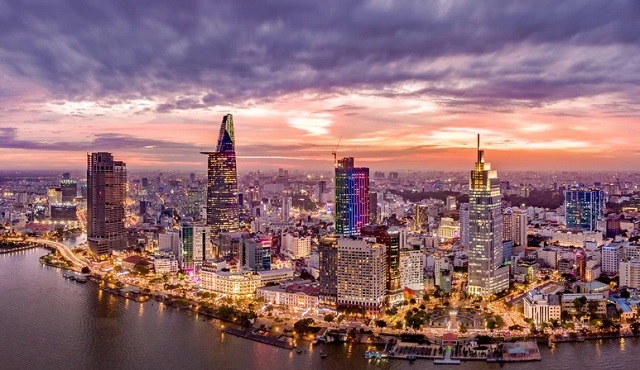
A bustling scene from Ho Chi Minh City. (Source: VNA)
|
Ho Chi Minh City aims high with a target of over 10% growth rate in its Gross Regional Domestic Product (GRDP) for 2025, alongside a services sector contribution of more than 60% to the GRDP, and a per capita GRDP of approximately $8,500.
These economic development goals for 2025 were approved by the Ho Chi Minh City People’s Council during their 20th meeting on December 11th, 2023.
The People’s Council of Ho Chi Minh City agreed on the theme for 2025, which is to “Focus on organizing a streamlined, strong, efficient, effective, and capable apparatus; accelerate digital transformation and implement Resolution No. 98/2023/QH15 of the National Assembly; fundamentally resolve the city’s bottlenecks and problems.”
In 2025, Ho Chi Minh City will prioritize leveraging its advantages, seizing opportunities, and optimizing its mechanisms and policies for special development. The city will enhance the quality and efficiency of management and planning while effectively allocating resources. Building on the achievements in infrastructure development, particularly in transportation, water supply, drainage, wastewater treatment, healthcare, education, and training, the city will emphasize the importance of key projects that foster regional linkages.
Ho Chi Minh City aims to capitalize on its infrastructure, market, human resources, and unique conditions to propel the growth of the digital economy. By fostering the interplay between digital transformation, green transition, and circular economy, the city will elevate the quality of its human capital. Additionally, it will promote scientific and technological advancements, innovation, cultural development, social security, and improved living standards for its citizens.
The city will also focus on administrative reforms, effectively implementing the urban administration model, while vigorously fighting corruption, negativity, and wastefulness. Strengthening national defense and security, firmly safeguarding independence and sovereignty, maintaining political security, and ensuring social order and safety are also key priorities.
Ho Chi Minh City strives for excellence in economic indicators, targeting a 25% contribution of the digital economy to GRDP. It aims for a total social investment capital of approximately 35% of GRDP, with a science and technology investment ratio of over 1% of GRDP, and a social labor productivity growth rate of 7%.
In terms of cultural and social development, the city aims for an 87.2% rate of trained workers with certificates or qualifications. It plans to create 140,000 new jobs, maintain an urban unemployment rate below 4%, and reduce the poverty rate by 0.04% (1,114 households) and the near-poor rate by 0.13% (3,553 households). The city aspires to eradicate poverty according to both national and city standards.
Ho Chi Minh City also sets ambitious targets for its healthcare and education sectors, aiming for a ratio of 21 doctors and 42 hospital beds per 10,000 people. In education, the city strives for a ratio of 300 classrooms per 10,000 people of school-going age (3–18 years old) and ensures that 100% of children within this age group attend school.
To achieve these goals, the city has outlined specific tasks and solutions, emphasizing the need to accelerate sustainable economic development, enhance productivity, quality, efficiency, and international competitiveness. Effective mobilization and utilization of investment resources are crucial for the city’s development. Emphasis is also placed on fostering industrial production, particularly in key industries with high added value, and continuing to ensure political stability and social order while effectively addressing issues related to religion and ethnicity.
In 2024, Ho Chi Minh City successfully achieved 18 out of 21 socio-economic targets, with some even surpassing the set goals. The city’s GRDP growth rate for 2024 reached 7.17%, approaching the planned target of 7.5 – 8.5%. The city’s efforts in promoting scientific and technological advancements in industrial development have been significant, with the four key industries continuing to drive growth. The industrial production index (IIP) for 2024 is estimated to increase by 7.3% compared to the previous year.
Ho Chi Minh City’s total retail sales of goods and consumer services revenue rose by 10.7%, while the city’s export turnover is estimated at $46 billion, an increase of 8.3%. The state budget revenue reached VND 502,000 billion, exceeding the annual plan by 4% and representing a 12% increase compared to the previous year.
The People’s Council of Ho Chi Minh City calls upon the people, cadres, and soldiers to uphold the spirit of unity, dynamism, and creativity to overcome challenges and successfully accomplish the city’s socio-economic tasks for 2025.
Xuân Khu
Unlocking Quang Tri’s Potential: Focusing on Renewable Energy and Tourism
In the North Central and Central Coastal Region Master Plan until 2023, Quang Tri Province is prioritized for renewable energy and tourism development.
Unlocking the Potential of Mixed-Use Development in Ho Chi Minh City
The People’s Committee of Ho Chi Minh City has instructed that the area of land converted from other types of land to residential land should be based on the actual land needs of each household and individual. This will ensure that all decisions are made in accordance with regulations.













































